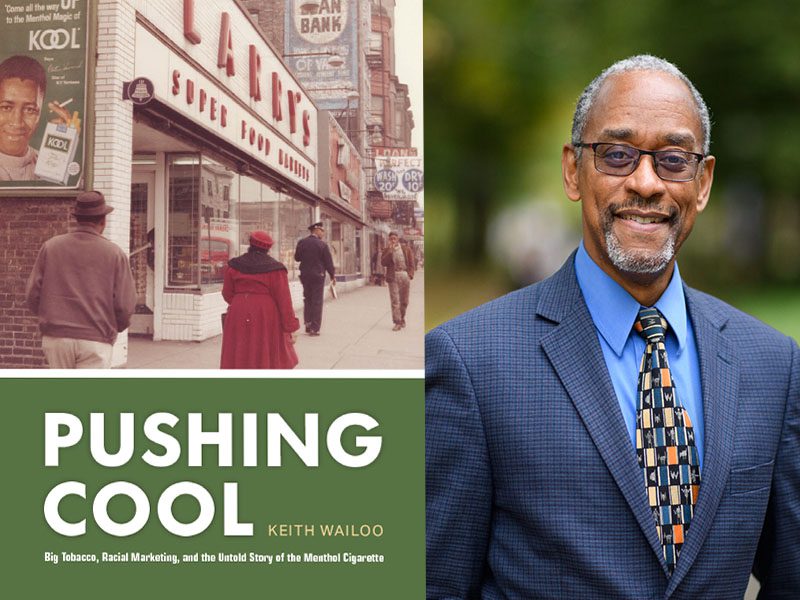Keith Wailoo is Henry Putnam University Professor of History and Public Affairs and President of the American Association for the History of Medicine. His book “Pushing Cool” will be published November 2, 2021, by Chicago University Press.
How did you get the idea for this project?
The book has several points of origin. First, as I explain in the prologue, I grew up in New York City in the 1970s surrounded by cigarette billboards for menthol brands. But when my family moved to suburban New Jersey, billboards were sparse. That urban-suburban disparity might be one starting point. A second point of origin might be watching the decades-long protests and legal actions against the industry and its targeted marketing unfold during later years. By the end of the 1990s, those billboards—for menthols and all brands—were banned. The third, and perhaps most significant, inspiration for the book is the events following the late 1990s lawsuits and settlement by state attorneys general and the Department of Justice against the tobacco industry. The settlement resulted in the creation of a massive archive that allows anyone to pull the curtain back and to answer questions about why billboards were built where they were, how targeted marketing worked, and how menthol cigarettes were created as a Black-themed smoking preference. So, the book may have been a very long time in the making, but the story of pushing cool—“untold story of the menthol cigarette”—only became possible to tell because of our ability to venture behind the scenes and chronicle the history of influence, marketing, and building of the web of supporters that sustained the industry’s “house of menthol.”
How has your project developed or changed throughout the research and writing process?
The most significant change in the book occurred because I was composing the conclusion when the coronavirus pandemic began and crafting it amid worldwide protests following the murder of George Floyd in Minneapolis in 2020. In this dire setting, the phrase “I can’t breathe” took on a new meaning. The now-familiar protest chant against police chokeholds and violence against Black people not only spoke to the tragedy of disproportionate deaths of Black people gasping for breath due to COVID, but it also resonated tragically with the long-term suffocating impact of menthol cigarette marketing in Black communities. My conclusion explains how the industry’s menthol strategy is part of this larger tragic convergence of storylines along the long, crooked road to “I can’t breathe.”
What questions for future investigation has the project sparked?
The book is a moment of closure for me, a culmination rather than an opening into new research questions. But I do hope others take the book as a point of departure. The question sparked by the book is: what comes next for the menthol cigarette as cities, states, and the federal government all contemplate banning these products? For readers, I also hope the book is a provocation to delve into the vast archives of the tobacco industry that yields such rich evidence and helped make this book possible. There are many more stories (about advertising, influence, identity, gender, class, smoking, and topics far beyond what I covered) to be told by examining the industry’s internal records. The records are filled with psychological reports, marketing proposals, sociological and economic studies—all of which give insight into a changing U.S. society, and to how culture and identity are studied by business, how behaviors are influenced, and how consumer and drug markets are made and sustained.
Why should people read this book?
The book makes a specifically historical case regarding a topic of intense debate in public policy today—whether to ban menthol cigarette smoking. To weigh in on that question, readers need to be informed about the long history of influence, persuasion, deception, and shrewd marketing (and the differences between them) in shaping and reshaping menthol smoking markets along lines of race, class, and gender. The book is interesting for another reason: the study of influence. Decades ago in the late 1950s, the journalist Vance Packard wrote an important book titled, The Hidden Persuaders. It is a phrase we might recognize today because we too live in an era where media influencers (hidden and not-so-hidden) shape beliefs, guide behavior, and fuel fractious political debates. Pushing Cool is about influencers and the shaping of smoking choices and behavior. It is a story that starts decades before Packard’s time and then connects his world to our own. So whether readers are interested in the history of targeted racial marketing, systemic racism, health disparities, menthol bans, or influence and market, the history of how mentholated tobacco products found racial markets will intrigue and perhaps also shock them.
Learn more about other publications by Princeton University faculty in the humanities by exploring our Faculty Bookshelf.
















